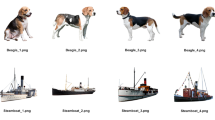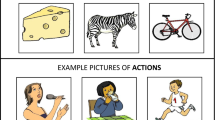Abstract
We present new Spanish norms for object familiarity and rated age of acquisition for 140 pictures taken from Snodgrass and Vanderwart (1980), together with data on visual complexity, image agreement, name agreement, word length (in syllables and phonemes), and five measures of word frequency. The pictures were presented to a group of 64 Spanish subjects, and oral naming latencies were recorded. In a multiple regression analysis, age of acquisition, object familiarity, name agreement, word frequency, and word length made significant independent contributions to predicting naming latency.
Article PDF
Similar content being viewed by others
Explore related subjects
Discover the latest articles and news from researchers in related subjects, suggested using machine learning.Avoid common mistakes on your manuscript.
References
Alameda, J. R., &Cuetos, F. (1995).Diccionario de frecuencias de las unidades linguísticas del castellano. Oviedo: Servicio de Publicaciones de la Universidad de Oviedo.
Bachoud-Lévi, A. C., Dupoux, E., Cohen, L., &Mehler, J. (1998). Where is the length effect? A cross-linguistic study of speech production.Journal of Memory & Language,39, 331–346.
Barry, C., Morrison, C. M., &Ellis, A. W. (1997). Naming the Snodgrass and Vanderwart pictures: Effects of age of acquisition, frequency and name agreement.Quarterly Journal of Experimental Psychology,50A, 560–585.
Beringer, J. (1995).Experimental run time system. Frankfurt: Beri-Soft.
Brown, G. D. A., &Watson, F. L. (1987). First in, first out: Word learning age and spoken word frequency as predictors of word familiarity and word naming latency.Memory & Cognition,15, 208–216.
Carroll, J. B., &White, M. N. (1973). Word frequency and age-ofacquisition as determiners of picture-naming latency.Quarterly Journal of Experimental Psychology,25, 85–95.
Ellis, A. W., &Morrison, C. M. (1998). Real age of acquisition effects in lexical retrieval.Journal of Experimental Psychology: Learning, Memory, & Cognition,24, 515–523.
Gilhooly, K. J., &Gilhooly, M. L. (1979). Age-of-acquisition effects in lexical and episodic memory tasks.Memory & Cognition,7, 214–223.
Hirsh, K. W., &Funnell, E. (1995). Those old, familiar things: Age of acquisition, familiarity and lexical access in progressive aphasia.Journal of Neurolinguistics,9, 23–32.
ICE (1977).Vocabulario básico del español y sus aplicaciones a la enseñanza. Oviedo: Instituto de Ciencias de la Educación.
Jescheniak, J. D., &Levelt, W. J. M. (1994). Word frequency effects in speech production: Retrieval of syntactic information and of phonological form.Journal of Experimental Psychology: Learning, Memory, & Cognition,20, 824–843.
Lachman, R., Shaffer, J. P., &Hennrikus, D. (1974). Language and cognition: Effects of stimulus codability, name-word frequency, and age of acquisition on lexical reaction time.Journal of Verbal Learning & Verbal Behavior,13, 613–625.
MEC (1989).Vocabulario básico en la E.G.B. Madrid: Ministerio de Educación y Ciencia and Editorial Espasa Calpe.
Morris, P. E. (1981). Age of acquisition, imagery, recall, and the limitations of multiple-regression analysis.Memory & Cognition,9, 277–282.
Morrison, C. M., Chappell, T. D., &Ellis, A. W. (1997). Age of acquisition norms for a large set of object names and their relation to adult estimates and other variables.Quarterly Journal of Experimental Psychology,50A, 528–559.
Morrison, C. M., &Ellis, A.W. (1995). The roles of word frequency and age of acquisition in word naming and lexical decision.Journal of Experimental Psychology: Learning, Memory, & Cognition,21, 116–133.
Morrison, C. M., Ellis, A. W., &Quinlan, P. T. (1992). Age of acquisition, not word frequency, affects object naming, not object recognition.Memory & Cognition,20, 705–714.
Ralph, M. A. L., Graham, K. S., Ellis, A. W., &Hodges, J. R. (1998). Naming in semantic dementia-what matters?Neuropsychologia,36, 775–784.
Sanfeliu, M. C., &Fernandez, A. (1996). A set of 254 Snodgrass-Vanderwart pictures standardized for Spanish: Norms for name agreement, image agreement, familiarity, and visual complexity.Behavior Research Methods, Instruments, & Computers,28, 537–555.
Snodgrass, J. G., &Vanderwart, M. (1980). A standardized set of 260 pictures: Norms for name agreement, image agreement, familiarity, and visual complexity.Journal of Experimental Psychology: Human Learning & Memory,6, 174–215.
Snodgrass, J. G., &Yuditsky, T. (1996). Naming times for the Snodgrass and Vanderwart pictures.Behavior Research Methods, Instruments, & Computers,28, 516–536.
Vitkovitch, M., &Tyrrell, L. (1995). Sources of disagreement in object naming.Quarterly Journal of Experimental Psychology,48A, 822–848.
Author information
Authors and Affiliations
Corresponding author
Additional information
This research was supported by Grant DGE-96-PB-0545 from the Spanish government. We thank Joan Snodgrass and Frances Connors for helpful comments on an earlier version of this article.
Electronic supplementary material
Rights and permissions
About this article
Cite this article
Cuetos, F., Ellis, A.W. & Alvarez, B. Naming times for the Snodgrass and Vanderwart pictures in Spanish. Behavior Research Methods, Instruments, & Computers 31, 650–658 (1999). https://doi.org/10.3758/BF03200741
Received:
Accepted:
Issue Date:
DOI: https://doi.org/10.3758/BF03200741




